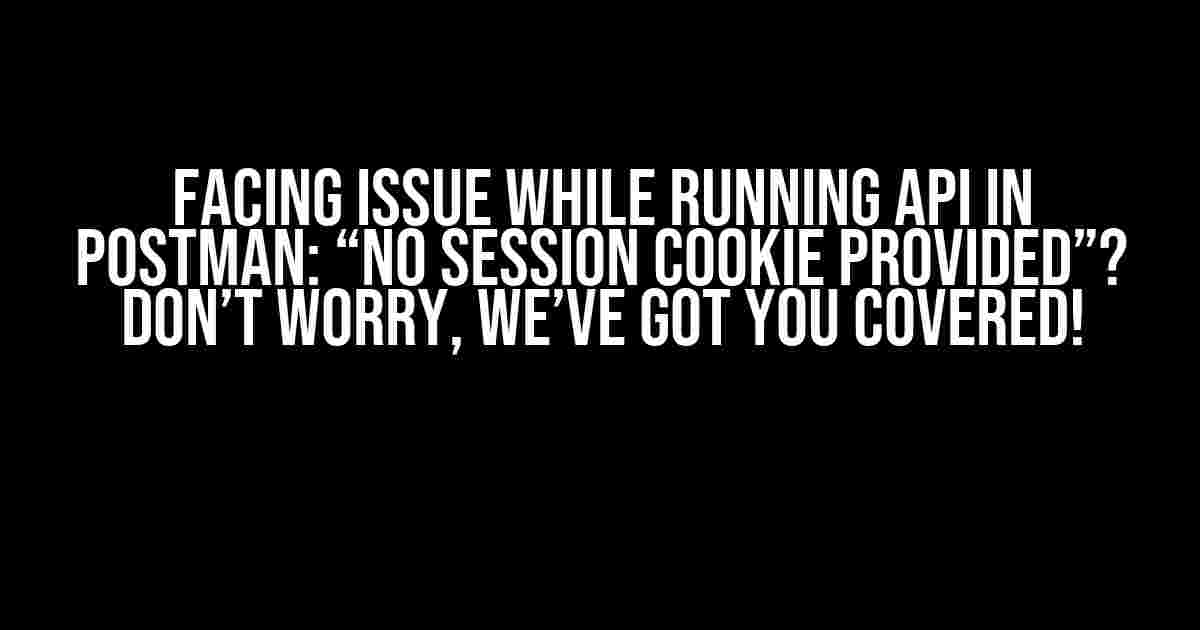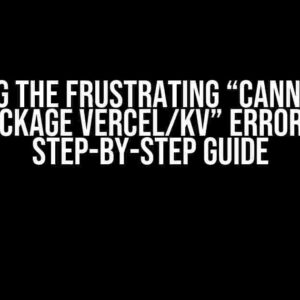Are you stuck with the frustrating “No session cookie provided” error while trying to run an API in Postman? Don’t sweat it, friend! You’re not alone. Many developers have been there, and we’re here to guide you through the troubleshooting process. In this article, we’ll dive into the reasons behind this error, and most importantly, provide you with step-by-step solutions to get your API up and running smoothly.
What causes the “No session cookie provided” error in Postman?
The “No session cookie provided” error typically occurs when Postman is unable to receive or send a session cookie, which is essential for authentication and authorization purposes. Here are some common reasons that might trigger this error:
- Improper API endpoint configuration: The API endpoint might not be set up correctly, leading to issues with session cookie management.
- Incorrect authentication method: Postman might be using the wrong authentication method, such as Basic Auth instead of Cookie Auth.
- Missing or expired session cookie: The session cookie might be missing or has expired, causing Postman to throw this error.
- Server-side issues: Problems with the server configuration or backend services can also lead to this error.
<
Step-by-Step Troubleshooting Guide
Now that we’ve identified the potential causes, let’s walk through the troubleshooting process to resolve the “No session cookie provided” error:
Step 1: Verify API Endpoint Configuration
Double-check the API endpoint configuration to ensure it’s set up correctly:
- Review the API documentation or contact the API provider to confirm the correct endpoint URL, method, and authentication requirements.
- Verify that the API endpoint is correctly configured in Postman, paying attention to the URL, method, headers, and authentication settings.
Step 2: Check Authentication Method
Ensure you’re using the correct authentication method:
- Check if the API endpoint requires Cookie Auth, Basic Auth, or another authentication method.
- In Postman, navigate to the “Authorization” tab and select the correct authentication method.
- Enter the required credentials, such as username and password, and make sure they’re correct.
Step 3: Inspect Session Cookies
Investigate the session cookie situation:
- In Postman, navigate to the “Cookies” tab.
- Check if a session cookie is present and has not expired.
- If the cookie is missing or expired, try re-authenticating or re-sending the request to obtain a new session cookie.
Step 4: Verify Server-Side Configuration
Rule out server-side issues:
- Contact the API provider or server administrator to confirm there are no server-side issues.
- Check the server logs for any errors or issues related to session cookie management.
Step 5: Clear Postman Cache and Cookies
Sometimes, a simple cache and cookie clearing can resolve the issue:
- In Postman, navigate to “File” > “Clear Cache and Cookies” (or press Ctrl + Shift + R on Windows or Command + Shift + R on Mac).
- Try re-running the API request to see if the issue persists.
Additional Troubleshooting Tips
If the above steps don’t resolve the issue, here are some additional troubleshooting tips:
- Check Postman version: Ensure you’re running the latest version of Postman. Update if necessary.
- Disable and re-enable Cookie Jar: In Postman, go to “File” > “Settings” > “Cookie Jar” and toggle the switch to disable and then re-enable it.
- Use the Postman Console: Open the Postman Console (Ctrl + Alt + C on Windows or Command + Option + C on Mac) to view detailed request and response information, which can help identify the issue.
Conclusion
The “No session cookie provided” error in Postman can be frustrating, but by following these step-by-step troubleshooting guide and additional tips, you should be able to resolve the issue and get your API up and running smoothly. Remember to stay calm, methodically work through the troubleshooting process, and don’t hesitate to reach out to the API provider or server administrator if needed. Happy API testing!
| Troubleshooting Step | Description |
|---|---|
| Verify API Endpoint Configuration | Review API endpoint configuration, API documentation, and Postman settings. |
| Check Authentication Method | Ensure correct authentication method is selected in Postman. |
| Inspect Session Cookies | Check for presence and expiration of session cookies in Postman. |
| Verify Server-Side Configuration | Rule out server-side issues by contacting API provider or server administrator. |
| Clear Postman Cache and Cookies | Clear Postman cache and cookies to resolve potential issues. |
// Example API request in Postman GET https://api.example.com/endpoint Authorization: Bearer YOUR_API_KEY Cookie: session_cookie=1234567890abcdef
Note: Replace `YOUR_API_KEY` with your actual API key and `session_cookie` with the actual session cookie value.
Frequently Asked Questions
Q: What is a session cookie?
A: A session cookie is a small piece of data stored on the client-side (in this case, Postman) to maintain session information and authenticate requests.
Q: Can I use Basic Auth instead of Cookie Auth?
A: While possible, it’s not recommended as Basic Auth sends credentials in plain text with each request, whereas Cookie Auth stores credentials securely in a cookie.
Q: How do I obtain a new session cookie?
A: Re-authenticate using the correct authentication method, or re-send the request to obtain a new session cookie.
By following this comprehensive guide, you should be able to overcome the “No session cookie provided” error and successfully run your API in Postman. Happy troubleshooting!
Frequently Asked Questions
Get answers to the most common issues when running APIs in Postman and resolve the “No session cookie provided” hurdle!
Q: What does the “No session cookie provided” error mean in Postman?
A: This error occurs when your API requires authentication and Postman is unable to send a valid session cookie with the request. This might be due to the cookie not being set, expired, or not being sent correctly.
Q: Why am I getting the “No session cookie provided” error despite having valid credentials?
A: Check if your API requires a specific domain or subdomain to set the session cookie. Make sure you’re sending the request to the correct domain and that your Postman settings are configured to send cookies for that domain.
Q: How do I set a session cookie in Postman?
A: You can set a session cookie in Postman by using the “Cookie” tab in the request builder. Enter the cookie key-value pair, and make sure the domain and path match the API’s requirements.
Q: What’s the difference between a session cookie and an authentication token?
A: A session cookie is a temporary identifier stored on the client-side, whereas an authentication token is a unique identifier sent in the request header to authenticate the request. Make sure you’re using the correct method for your API’s authentication requirements.
Q: How do I troubleshoot the “No session cookie provided” error in Postman?
A: Try checking the Postman console for error messages, verifying your API’s authentication requirements, and testing the API with a different tool or browser to isolate the issue.





